We picked up speed, heading east out of Sarajevo. The day was sunny, but we weren’t into it. We weren’t very into Serbia, either, but we were going there.
Just when you think you have things figured out, they get complicated again. We’d spent a week in Bosnia and Herzegovina, filling in the blanks from when the Balkans were front and center with the media in the 1990s. Or, we realized, perhaps we still only had part of the story. Too hard to say. But we were definitely heading into Serbia with mixed feelings.
We realized our heads weren’t into Serbia all that much because our hearts were heavy. We’d seen first hand how Serbs had decimated Bosnia and Herzegovina twenty years before. We’d reluctantly abandoned our initial plan to swing in and out of Kosovo, another place the Serbs haven’t played nice, for lack of time. And we weren’t even sure we should go to Belgrade at all, as we’d had a memorable conversation with a Serb in Brussels a month prior. Skip Belgrade and go to Novi Sad was his advice. We didn’t take it.

The statue of Pobednik, the Victor, commemorates Serbia’s victory over the Ottomans in the Balkan Wars, and over Austria-Hungary in World War I. The “Naked Man” was controversial, so they placed him at the Fortress, but facing away from the city. Now, of course, he’s front and center with New Belgrade on the other side of the Sava.
Delivered into Serbia along a back way past the Belgrade airport, our route passed old hulking warplanes at rest in a boneyard of gunmetal parts. Snaking up the riverbank to drop off other passengers, we caught a shocking glimpse of little kids poking through a smoking trash pit. Entire neighborhoods were unkempt; dried grass and weeds were knee-high on boulevards, bus stops stood as forlorn targets in a wasteland of nothingness between boxy Cold War high-rises and abandoned storefronts. Everything was layered with graffiti. It seemed as though the outskirts of Belgrade weren’t even trying to convince anyone she was keeping up appearances.
At Republic Square, we were deposited curtly. From gestures, we understood we should walk along the pedestrian area for an indeterminate amount of time. Searching in vain for street signs hidden on building corners in impossible to discern Cyrillic characters, we pirated a restaurant wi-fi signal and got our bearings. It was beastly hot as we stumbled, disoriented, near heat stroke, dragging our baggage toward Kneza Mihaila and the hotel.
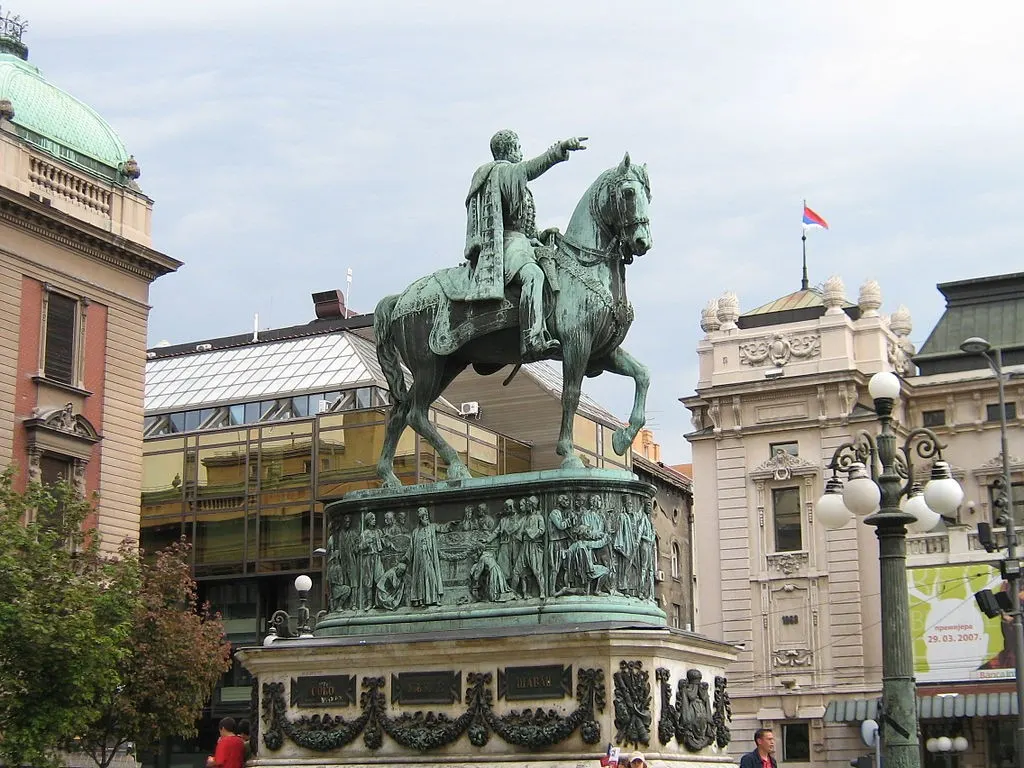
Prince Mihailo statue in Republic Square – “meet me at the horse” is a common thing to say when making plans. Image Credit: Wikipedia
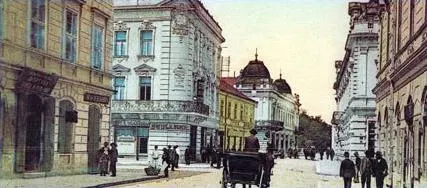
A 19th century view of Kneza Mihaila. Image Credit: Wikipedia
Kneza Mihaila is named for Mihailo Obrenovic, Prince of Serbia, deemed the most enlightened of its modern rulers. Mihailo advocated a Balkan federation in the 19th century against the Ottomans. He was successful at using diplomacy, bolstered by Russian and Austrian support, to persuade Turkish forces to leave garrisons and fortresses from multiple Serbian cities in the 1860s.
Kneza Mihaila, we learned, is also on top of the old Roman road which stretched from the Belgrade fortress of Kalemegdan to Sofia and on to Istanbul. Emperors Constantine the Great and Flavius Iovianus (Jovian) – who re-established Christianity as the Roman Empire’s official religion – were both born here. At one point, Belgrade was second in size only to Constantinople in the Ottoman Empire.
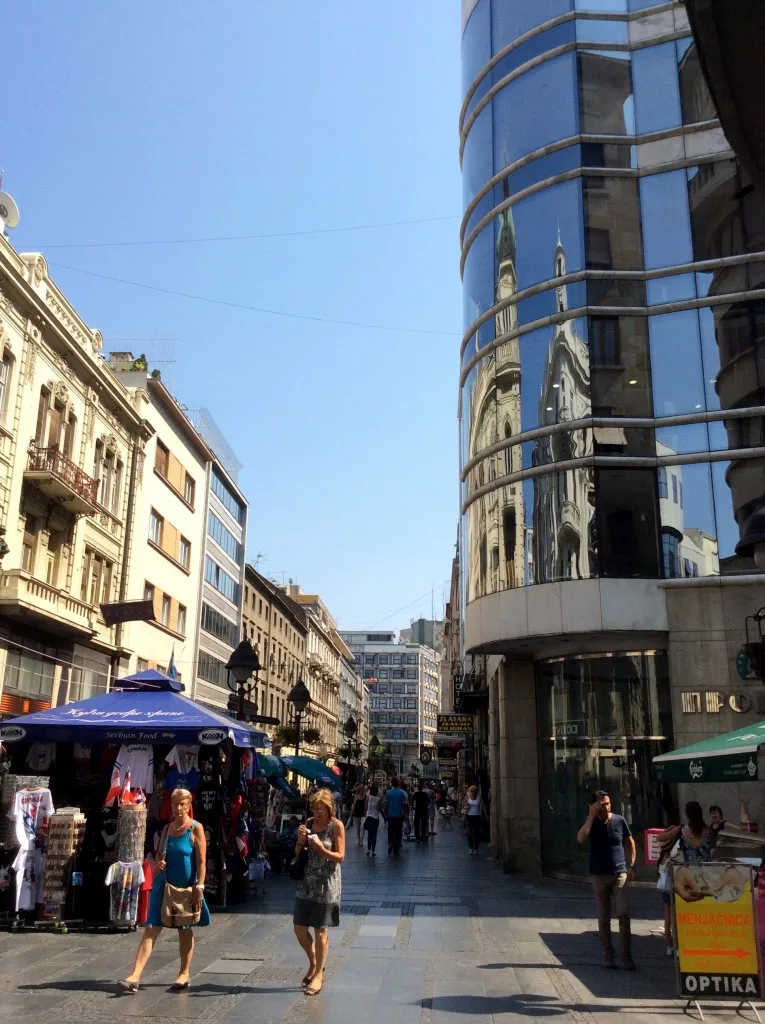
Old and new reflected on Kneza Mihaila
But long before Romans, Byzantines and Ottomans, Belgrade was a strategic location where the Sava and Danube rivers meet. Inhabited since Neolithic times, Belgrade’s 7000 year history includes over 100 wars, with invasions from Celts, Slavs, Bulgarians, Hungarians, Habsburgs and WWII Axis forces. The city has been destroyed and rebuilt more than 40 times.
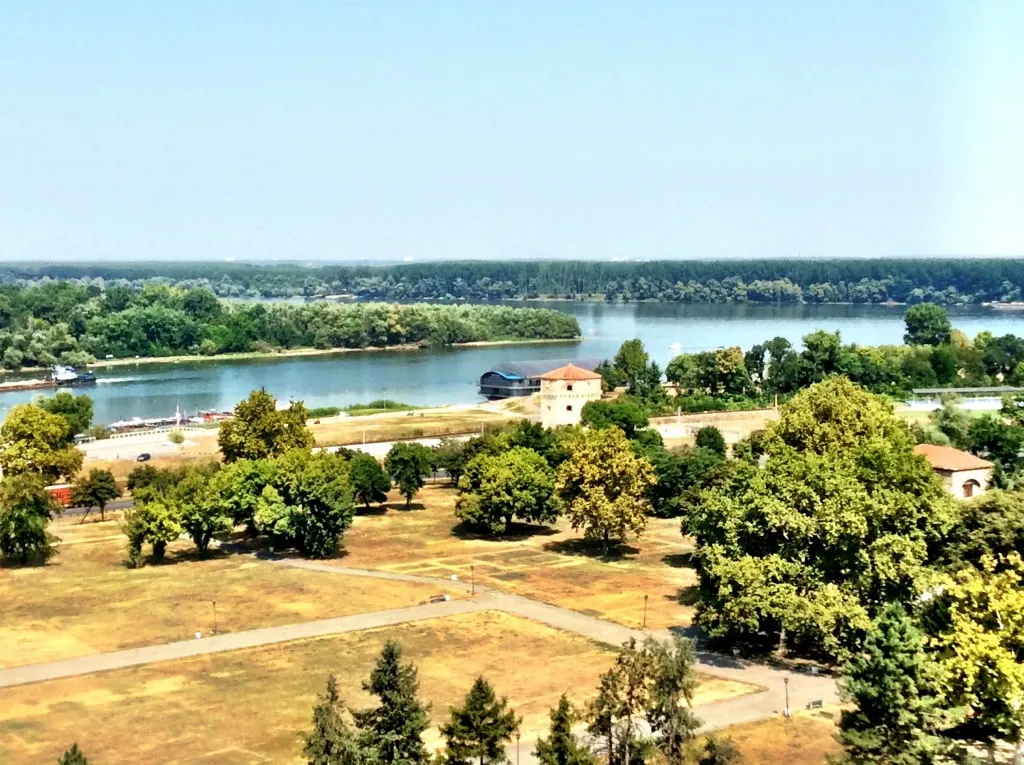
The confluence of the Sava and Danube Rivers as seen from the Kalemegdan fortress, strategically important for 7000 years.
We realized none of this as we later ventured out for dinner on what had become a pleasant summer’s evening. From the vantage of one of the many outdoor restaurants in the central promenade, this Belgrade was vibrant, stylish, friendly, and while perhaps not the prettiest European capital, sufficiently attractive.
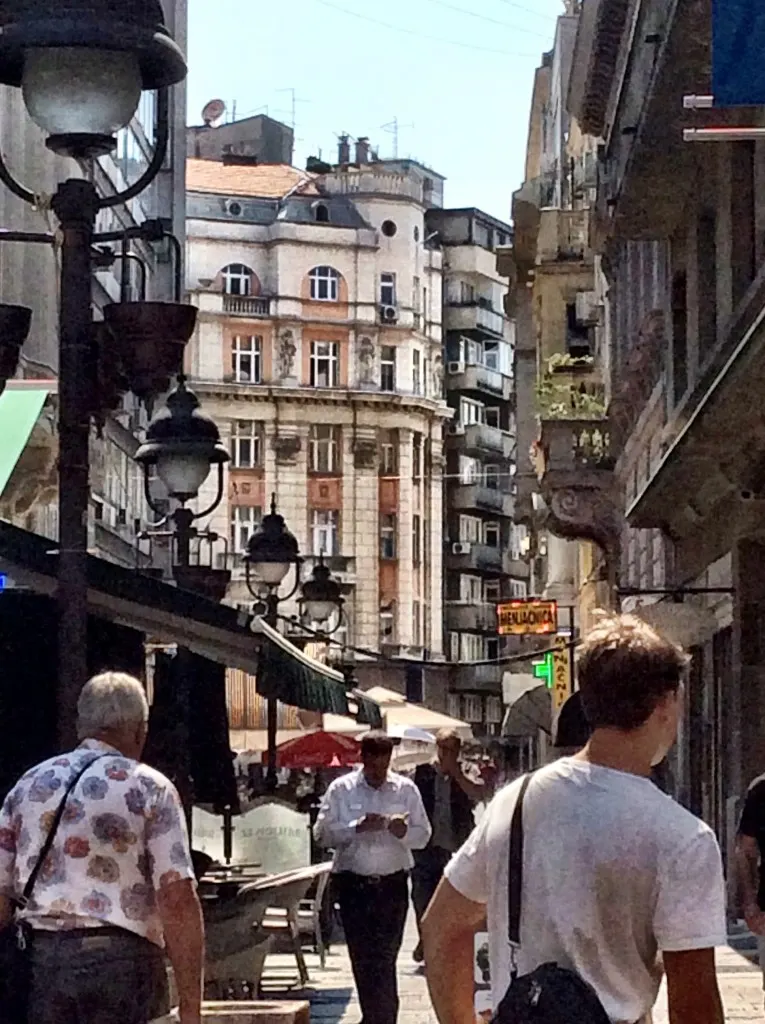
Belgrade may not be the most beautiful European capital, but she’s pretty and has an interesting personality
———
“Which would you have been back then?” I asked. “A partisan or a monarchist?” Demir paused. “A partisan,” came the firm reply.
We’d just come from the National Bank of Serbia Visitors Centre, where a cheeky “to-do” had us sitting for a mug shot. Our faces were then placed on replica 500 billion dinar notes. This incredible denomination was issued during hyperinflation in 1993, a result of the United Nations boycott of Yugoslavia. In January 1994, at its peak, the rate of inflation in Belgrade was 313 billion percent.
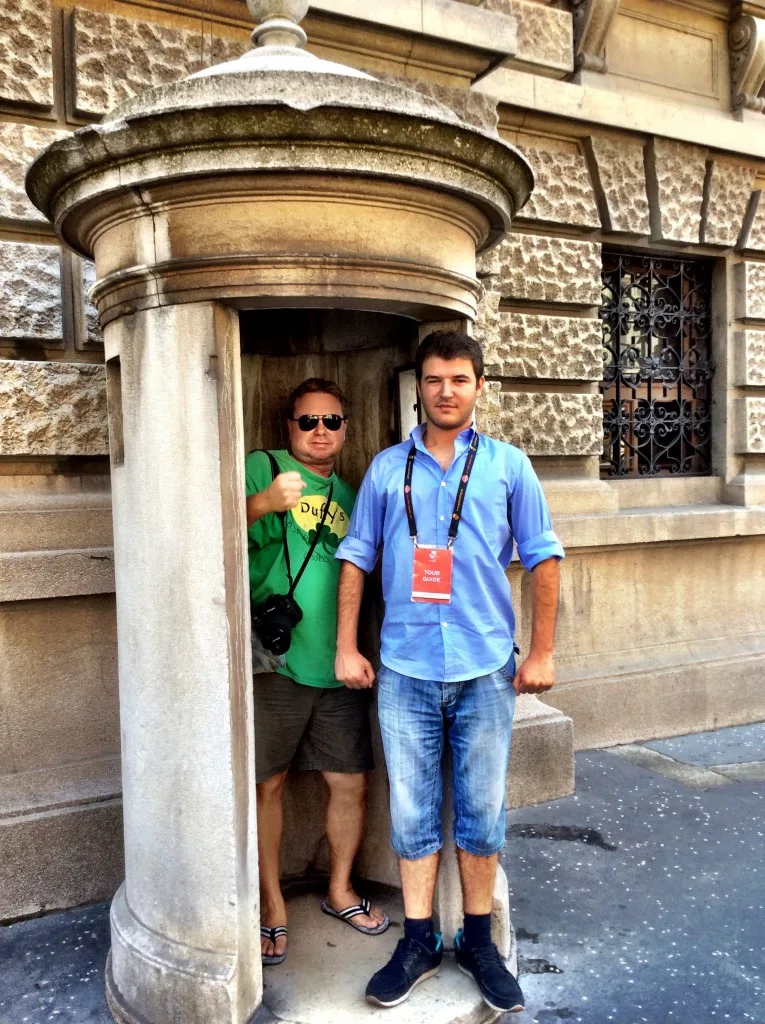
Pete and Demir looking fierce in the guard shelter outside the National Bank of Serbia
Demir, our guide from Go2Serbia, had described himself as a geographer and historian earlier that morning. “You’re not like Germans, are you?” was one of his first observations of us, conveyed with a twinkling eye. “Germans always tell me they’ve read otherwise. They do a lot of reading, but they’re not always very well-informed.” I decided not to answer directly, the possibility of us being far less informed than a German quite distinct. Instead, I told him we wanted to know what he thought was important. “You’re the expert here,” I said. “This is your town. In Hawaii, we say ‘talk story.’ Talk story about Serbia.”
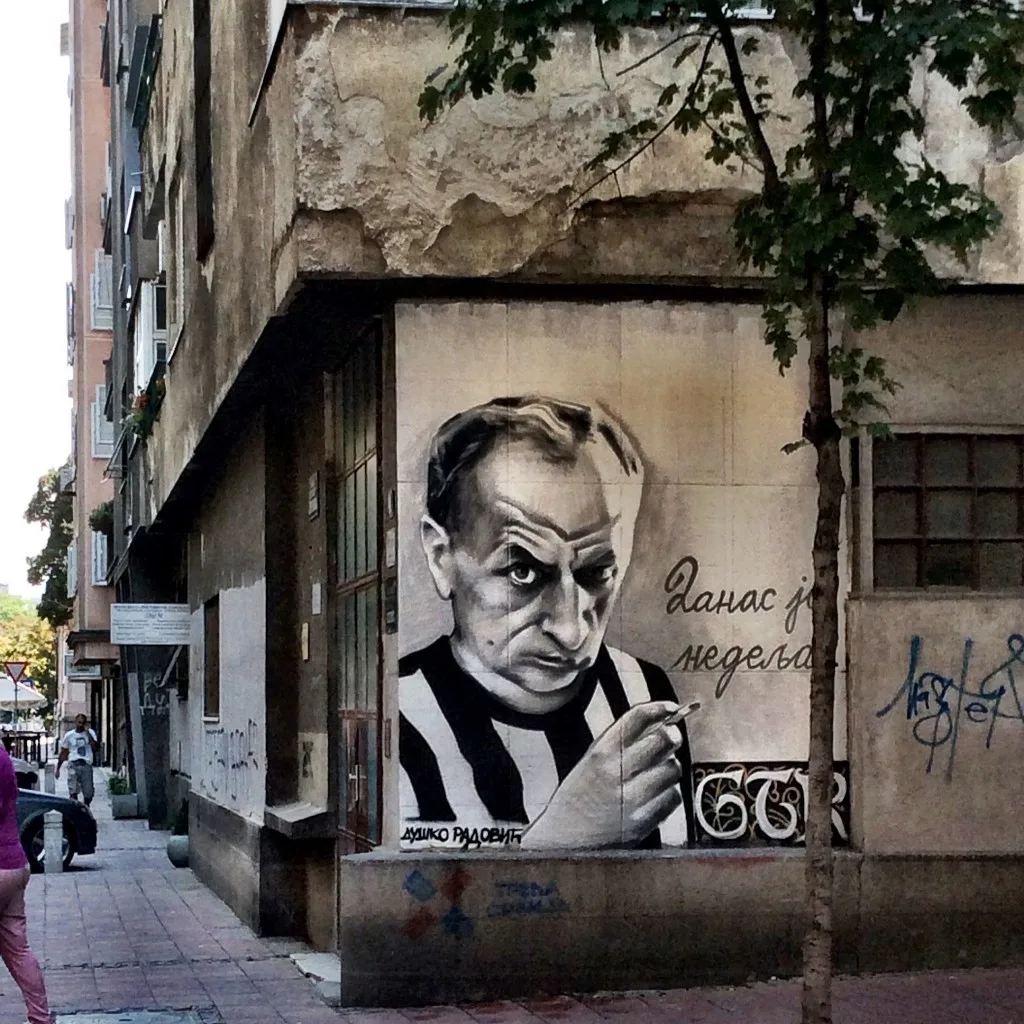
Street art depicting author and TV personality, Dusko Radovic. Beloved for striving “to free us of stupidity, the authorities, bad habits, insensitivity to kindness” and “seeing the world with the soul of a child.” Regularly in political trouble during his lifetime (1922-84) for opposing social realism.
Our walk was to take us through seventy centuries of history compressed in an area of no more than three square kilometers. It was another scorching day. Demir kindly slowed his pace so that we oldsters could keep up, and as we plodded obediently along behind him like sweaty little ducklings, he talked story about his city and his country.
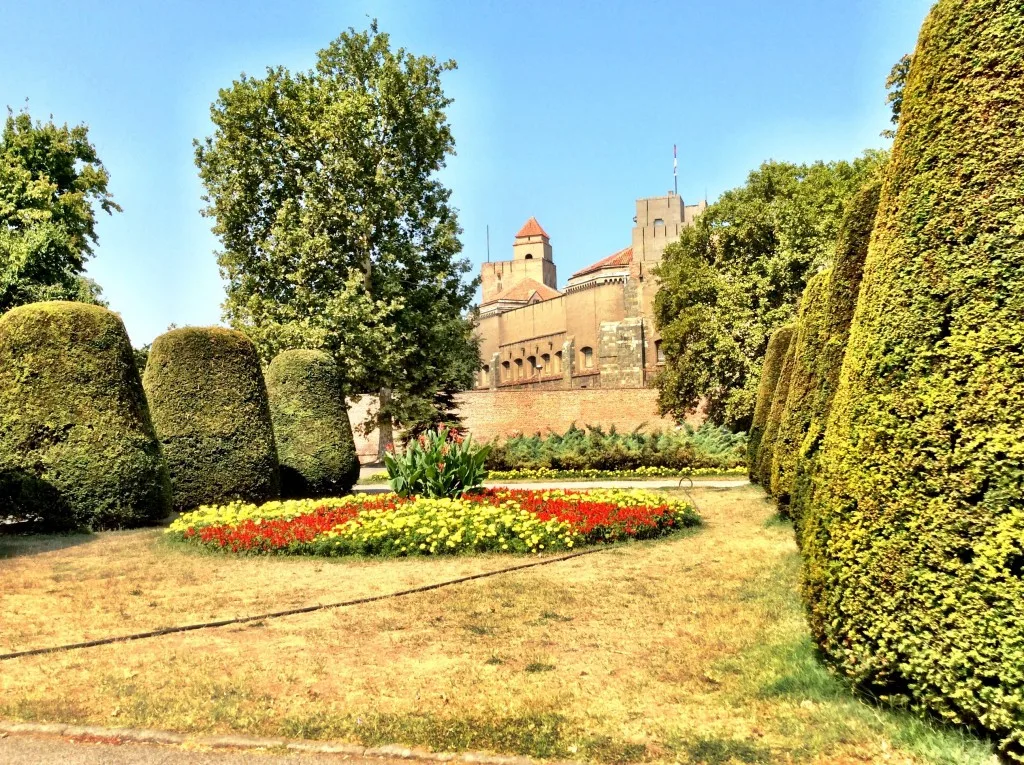
The old Roman route heads toward the Fortress of Belgrade
All this was not chronological. The circular route we took painted an Impressionist look into Serbia: step closer to the painting and the elements are indiscernible, step back and the image emerges. Pride, strength, adversity, internal misunderstandings and international disagreements, invasions, despots, reformers, the influence of literati and intelligentsia, all melded, laced with Demir’s sardonic humor.
We heard the story of Princess Ljubica, the mother of Prince Mihailo, whose husband, Prince Milos Obrenovic, built her a fine house in Belgrade. Unlike her husband, whose personality was harsh and autocratic, she took an active interest in Serbian politics. Serbs hated him and loved her. Milos refused to live there, preferring to be unfaithful with a series of mistresses in other locations, and she scorned him for being fearful of his countrymen. He was later forced to abdicate in favor of his son.
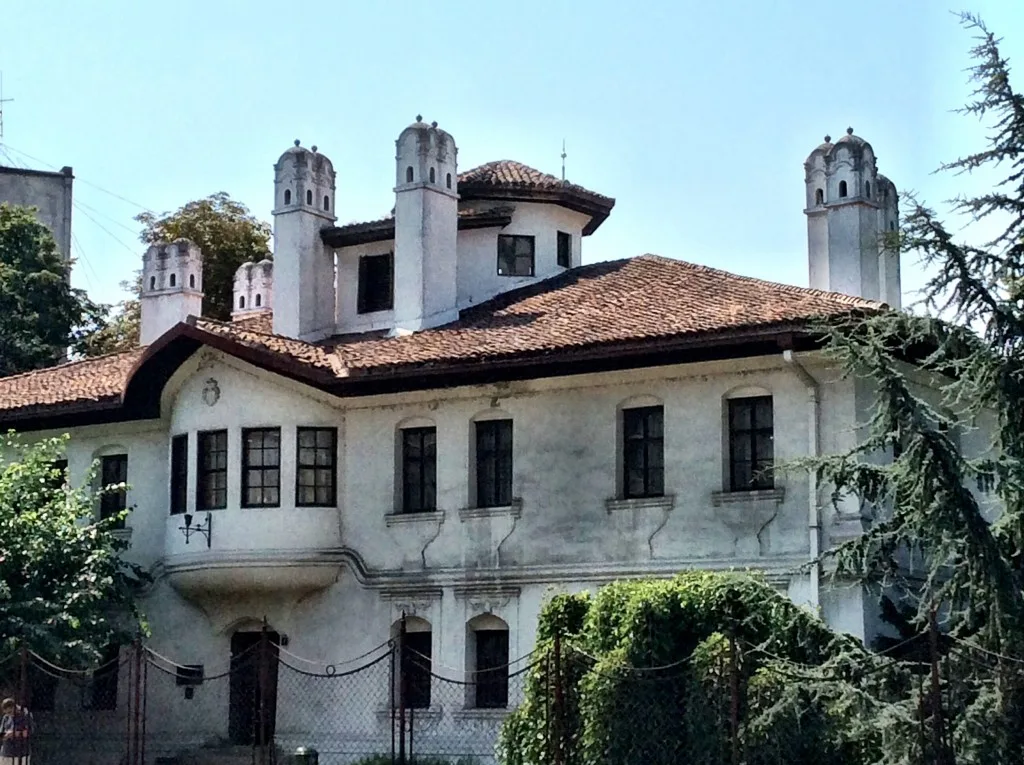
The residence of Princess Ljubica, mother of Prince Mihailo
We saw the famous Kafana ?, the oldest tavern in Belgrade. Located in a building which once belonged to Prince Milos, its owner annoyed Orthodox Church officials. They objected that his close location to the cathedral was as unseemly as the tavern’s “At the Cathedral” name. He responded by changing the name to ?, the question mark symbolic of being ever unable to please them.
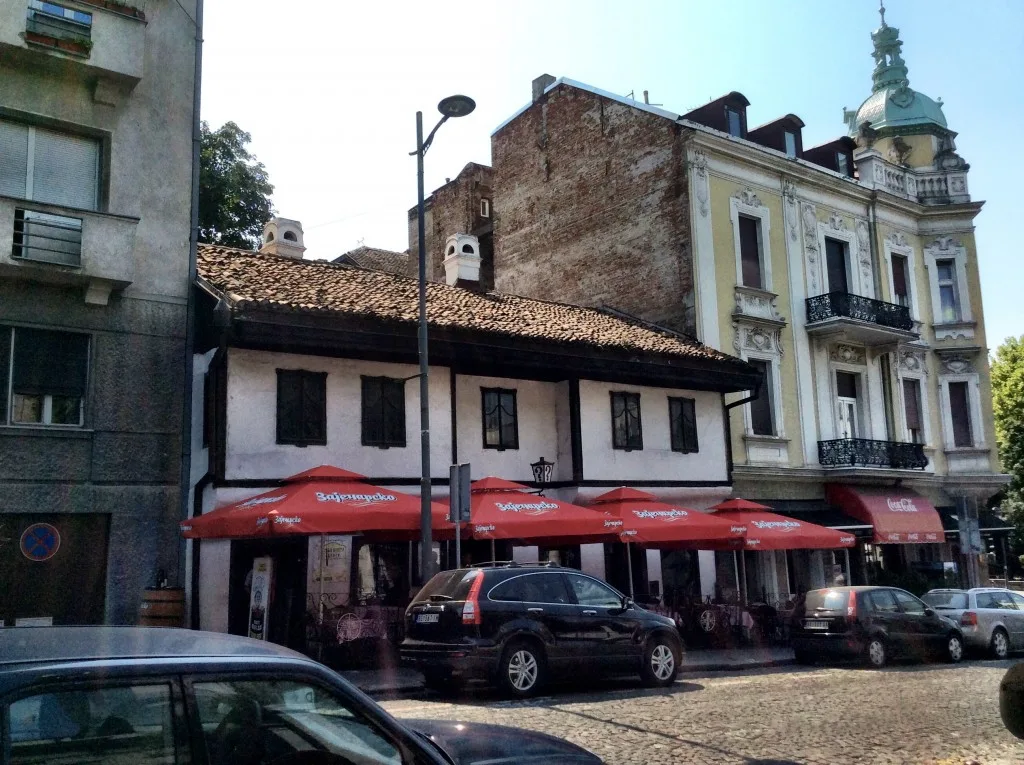
Kafana ? – the oldest tavern in Belgrade. Note the “?” on the light fixture.
We heard about Tito, always characterized as a bad guy in our history books back home. After his partisans fended off the Nazis, he went on to thwart Stalin from consuming Yugoslavia into the Cold War Soviet bloc. Naturally, Stalin wasn’t happy about this, but Tito wrote Stalin a personal letter, which Demir quoted verbatim:
Stop sending people to kill me. We’ve already captured five of them, one of them with a bomb and another with a rifle. If you don’t stop sending killers, I’ll send one to Moscow, and I won’t have to send a second. — Josip Broz Tito
We began to understand why Tito, whose partisans assisted escaping Jews, who had the backing of Roosevelt, Churchill and Stalin at the Tehran conference, who worked with Nehru, Sukarno, Nasser and others to form the Non-Aligned Movement, resonated. Under Tito, Yugoslavia “became a bright spot amid the general grayness of Eastern Europe.” And we inferred how when Tito, whose forceful personality had been the glue that held Yugoslavia together internally and on the world stage, died in 1980, the void which remained allowed things to fall swiftly apart.
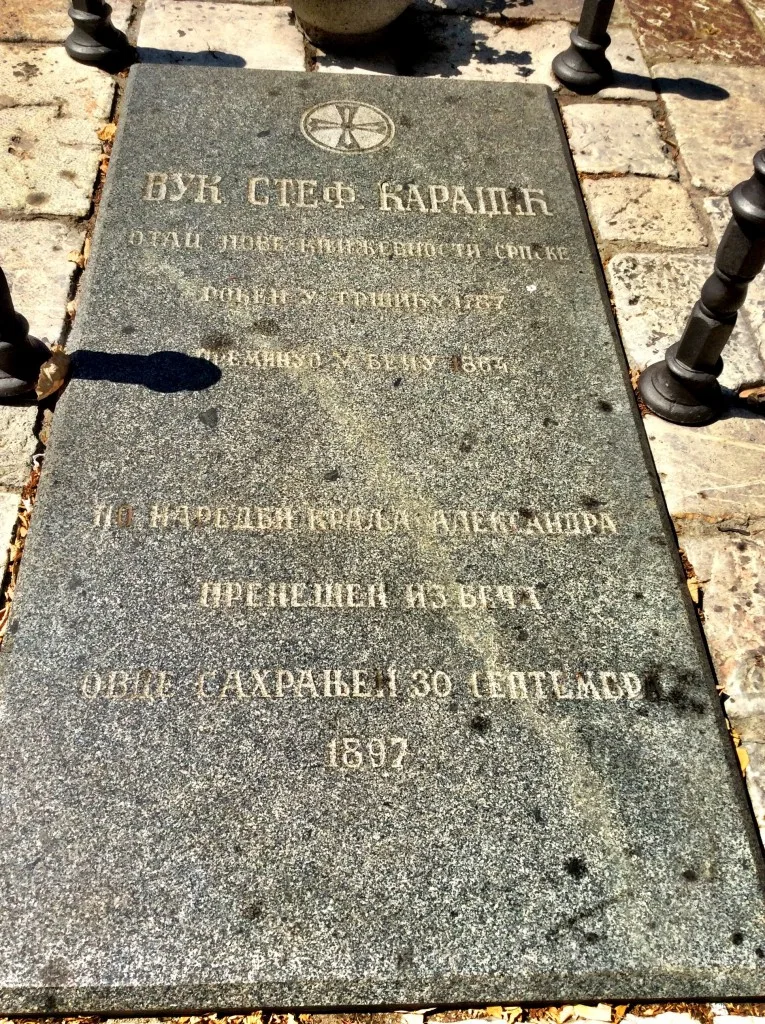
The grave of Vuk Karadzic, who reformed and clarified the Serbian Cyrillic alphabet in the 19th century. His works were banned by Prince Milos. A contemporary of the Brothers Grimm and Goethe, his motto was “write as you speak and read as it is written.” We, unfortunately, can do neither in this language.
———
“See? Nah-tow!” the cabbie angrily pointed to a burned-out facade which had once been a building. What is he talking about, we wondered. Then it dawned. . .
For about 10 weeks in 1999, NATO conducted air strikes on Serbia, using military force for the first time without the approval of the United Nations. The intention at first was to destroy military infrastructure without using ground units. But then, additional strategic targets were hit with long-range cruise missiles: bridges, government buildings, factories, and infrastructure such as power and water plants, and the state broadcasting system.
![Into Serbia 13 David Orlovic (Own work) [CC BY-SA 3.0 (https://creativecommons.org/licenses/by-sa/3.0)], via Wikimedia Commons](https://fc9b5.bigscoots-temp.com/wp-content/uploads/2015/09/NATO_damage_in_Belgrade.jpg.webp)
The remains of the Ministry of Defense building – bombed by NATO forces in 1993. Photo Credit: David Orlovic (Own work) [CC BY-SA 3.0 (https://creativecommons.org/licenses/by-sa/3.0)], via Wikimedia Commons
Stunned, we attempted empathetic conversation but faltered with the banal. “Trump!” he exclaimed. This driver wasn’t really an English speaker, and it became clear that he needed to pay attention to traffic. Preoccupied and uneasy with our thoughts, we were silent as he fiddled with his GPS and the radio. The building we passed that day, as it turns out, was Yugoslavia’s Ministry of Defense. The site will be razed by the Trump organization for a planned hotel.
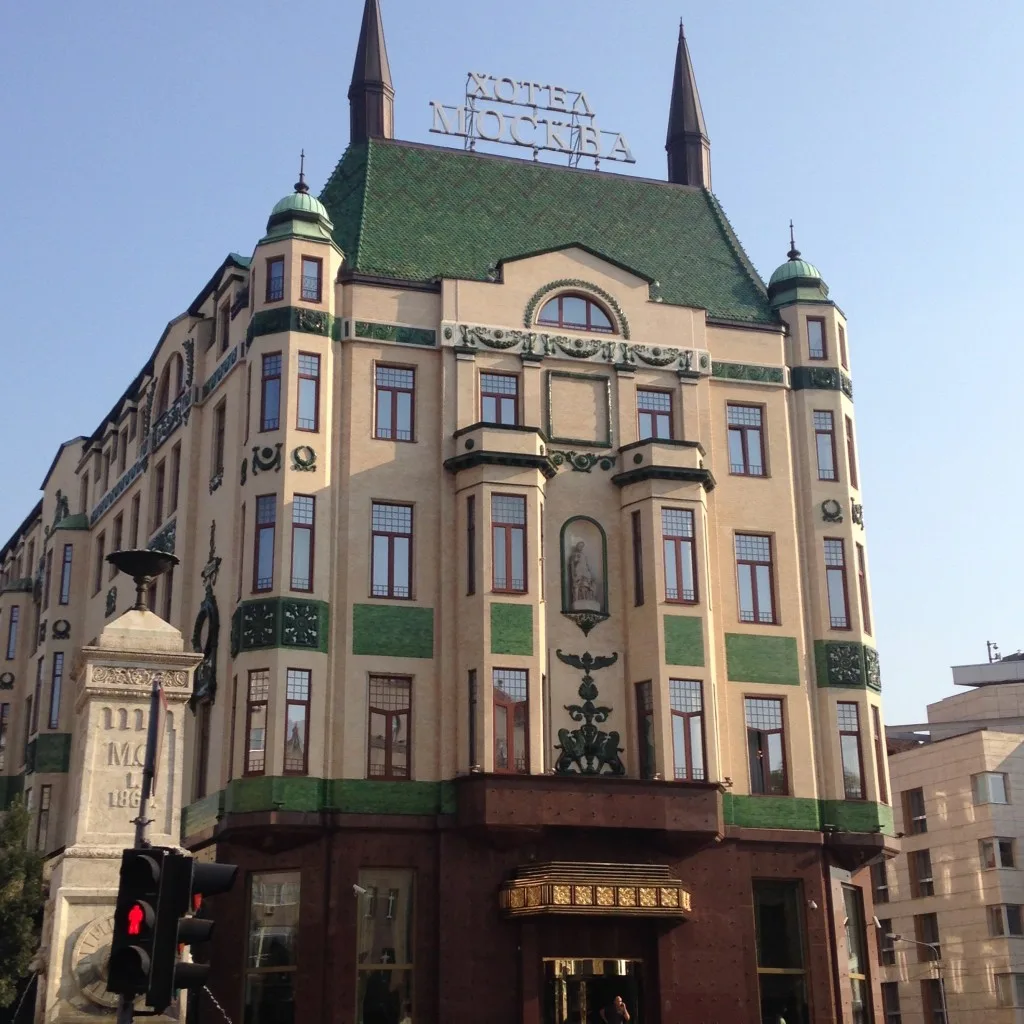
The Hotel Moscow on Terazije Square – built in what’s called “the style of the Russian secession” in 1908.
Our ride stopped at Terazije Square, the central point from which all Belgrade street numbers originate in every direction. Terazije, loosely translated, means “scales” or “balances.” While it probably refers to a Roman aqueduct or other water redistribution system, I thought of justice and equilibrium. Turning around with his hand out for cash, our driver demanded ten times the going rate. We paid it and stepped out into the sunlight.
Our virtues and our failings are inseparable, like force and matter. When they separate, man is no more. – Nikola Tesla
Pinnable Image:
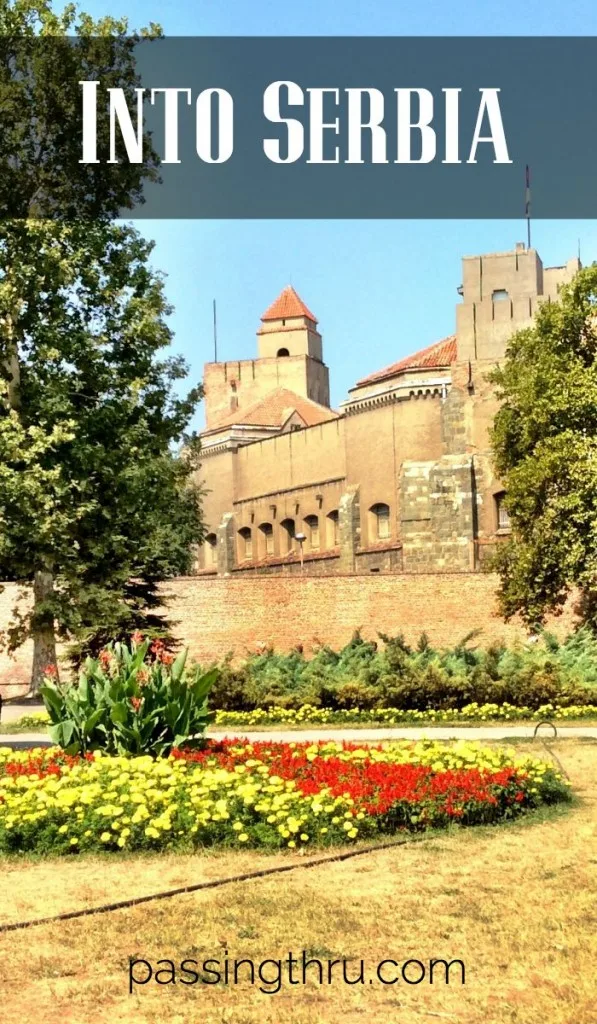
Tips and Practicalities:
Go2Serbia offers a similar walking tour to ours from €5, as well as other themed tours such as Belgrade Underground, World War I, pub and nightlife crawls and a portal for hotel and hostel booking.
Our look into Serbia was part of a promotional rate we paid with Belgrade Art Hotel, a four-star property with an exceptional location in the city center. Kneza Mihaila 27, 11000 Belgrade. Tel +381 11 3312 000. Our spacious room was newly and luxuriously decorated. The hotel’s contemporary art-filled atmosphere is tranquil. The hotel has an a la carte restaurant, cocktail lounge and a whimsical waffle and ice cream bar. Free wi-fi and small pet-friendly.
Tips for Trip Success
Book Your Flight
Find an inexpensive flight by using Kayak, a favorite of ours because it regularly returns less expensive flight options from a variety of airlines.
Book Your Hotel or Special Accommodation
We are big fans of Booking.com. We like their review system and photos. If we want to see more reviews and additional booking options, we go to Expedia.
You Need Travel Insurance!
Good travel insurance means having total peace of mind. Travel insurance protects you when your medical insurance often will not and better than what you get from your credit card. It will provide comprehensive coverage should you need medical treatment or return to the United States, compensation for trip interruption, baggage loss, and other situations.Find the Perfect Insurance Plan for Your Trip
PassingThru is a participant in the Amazon Services LLC Associates Program. As an Amazon Associate I earn from qualifying purchases.
To view PassingThru’s privacy policy, click here.

A Review of Guided Walking Tours Around the World
Thursday 7th of April 2016
[…] to Betsy Wuebker from Passing Thru for sharing her experiences while visiting […]
Jenny @ Till the Money Runs Out
Sunday 27th of September 2015
It is always amazing to me how many different factors affect my experience of a place! Knowing the history of where I am visiting, or where I visited before, or even my mood or energy level can really drastically change my perception of a place. Loved reading about your experiences and getting to see what shaped them.
Betsy Wuebker
Sunday 27th of September 2015
Hi Jenny - Yes, it's true. Our individual lenses vary and we may arrive (or at least we do, anyway) expecting a certain context. But we've tried to remain aware of doing this and be open to what presents itself.
Lisa Chavis
Sunday 27th of September 2015
Really great article, Betsy! We've avoided Serbia for many of the same reasons you've mentioned. Listening to family members describe the atrocities that happened certainly have kept our feelings for this area low. But your post is encouraging and something I enjoyed reading to learn more about the area. Thanks so much for sharing it with us!
Betsy Wuebker
Sunday 27th of September 2015
Hi Lisa - Yes, it helped to learn that from the Serbian POV, the breakup of the former Yugoslavia was more civil war, with the aim being to keep it intact as Tito had done. Once we heard this, it wasn't hard to analogize it with our own Civil War in the 19th century. And, of course, as individuals, we often have very little say in what our governments do. There are many who did not support Milosevic's regime. Not trying to create moral equivalencies here, but just trying more to understand. Imagine if Americans had not been open to visiting Germany in the 1950s and 1960s.
Henry | @fotoeins
Sunday 27th of September 2015
I'm biased by two things: (1) recent history of the civil war, and how in many respects Serbia is on the "wrong side" of moral judgement, and (2) how this part of the world has centuries' worth of history. As I read your post, I thought about it was very much like giving Belgrade and Serbia a chance.
Betsy Wuebker
Sunday 27th of September 2015
Hi Henry - Yes, we hold similar biases when it comes to the war. That said, when we visited Russia last year, we were struck by how highly regarded Putin is in his country for reasons having little to do with the reasons he is not highly regarded in the West. It was a similar realization when we began to hear about Tito, who is revered in Belgrade. Our understanding became more about incorporating these complexities.
Suzanne Stavert
Thursday 24th of September 2015
I always feel so better informed after reading your posts. What an interesting place filled with history and heartache. Thank you for the virtual tour.
Betsy Wuebker
Friday 25th of September 2015
Hi Suzanne - thank you! It was a good experience!